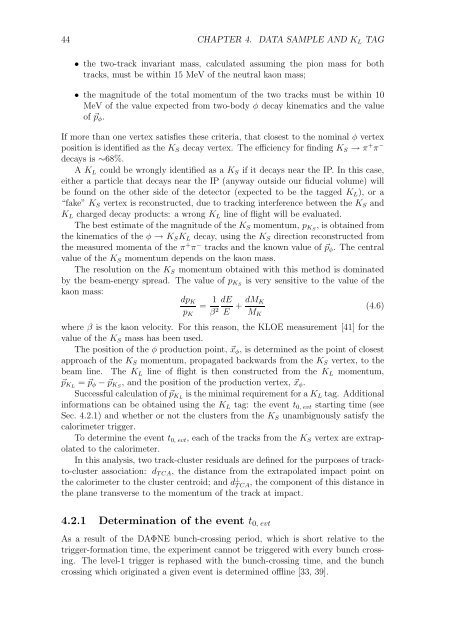Universit`a degli studi Roma Tre Measurement of the KL meson ...
Universit`a degli studi Roma Tre Measurement of the KL meson ...
Universit`a degli studi Roma Tre Measurement of the KL meson ...
You also want an ePaper? Increase the reach of your titles
YUMPU automatically turns print PDFs into web optimized ePapers that Google loves.
44 CHAPTER 4. DATA SAMPLE AND <strong>KL</strong> TAG<br />
• <strong>the</strong> two-track invariant mass, calculated assuming <strong>the</strong> pion mass for both<br />
tracks, must be within 15 MeV <strong>of</strong> <strong>the</strong> neutral kaon mass;<br />
• <strong>the</strong> magnitude <strong>of</strong> <strong>the</strong> total momentum <strong>of</strong> <strong>the</strong> two tracks must be within 10<br />
MeV <strong>of</strong> <strong>the</strong> value expected from two-body φ decay kinematics and <strong>the</strong> value<br />
<strong>of</strong> pφ.<br />
If more than one vertex satisfies <strong>the</strong>se criteria, that closest to <strong>the</strong> nominal φ vertex<br />
position is identified as <strong>the</strong> KS decay vertex. The efficiency for finding KS → π + π −<br />
decays is ∼68%.<br />
A <strong>KL</strong> could be wrongly identified as a KS if it decays near <strong>the</strong> IP. In this case,<br />
ei<strong>the</strong>r a particle that decays near <strong>the</strong> IP (anyway outside our fiducial volume) will<br />
be found on <strong>the</strong> o<strong>the</strong>r side <strong>of</strong> <strong>the</strong> detector (expected to be <strong>the</strong> tagged <strong>KL</strong>), or a<br />
“fake” KS vertex is reconstructed, due to tracking interference between <strong>the</strong> KS and<br />
<strong>KL</strong> charged decay products: a wrong <strong>KL</strong> line <strong>of</strong> flight will be evaluated.<br />
The best estimate <strong>of</strong> <strong>the</strong> magnitude <strong>of</strong> <strong>the</strong> KS momentum, pKS , is obtained from<br />
<strong>the</strong> kinematics <strong>of</strong> <strong>the</strong> φ → KS<strong>KL</strong> decay, using <strong>the</strong> KS direction reconstructed from<br />
<strong>the</strong> measured momenta <strong>of</strong> <strong>the</strong> π + π − tracks and <strong>the</strong> known value <strong>of</strong> pφ. The central<br />
value <strong>of</strong> <strong>the</strong> KS momentum depends on <strong>the</strong> kaon mass.<br />
The resolution on <strong>the</strong> KS momentum obtained with this method is dominated<br />
by <strong>the</strong> beam-energy spread. The value <strong>of</strong> pKS is very sensitive to <strong>the</strong> value <strong>of</strong> <strong>the</strong><br />
kaon mass:<br />
dpK<br />
=<br />
pK<br />
1<br />
β2 dE dMK<br />
+ (4.6)<br />
E MK<br />
where β is <strong>the</strong> kaon velocity. For this reason, <strong>the</strong> <strong>KL</strong>OE measurement [41] for <strong>the</strong><br />
value <strong>of</strong> <strong>the</strong> KS mass has been used.<br />
The position <strong>of</strong> <strong>the</strong> φ production point, xφ, is determined as <strong>the</strong> point <strong>of</strong> closest<br />
approach <strong>of</strong> <strong>the</strong> KS momentum, propagated backwards from <strong>the</strong> KS vertex, to <strong>the</strong><br />
beam line. The <strong>KL</strong> line <strong>of</strong> flight is <strong>the</strong>n constructed from <strong>the</strong> <strong>KL</strong> momentum,<br />
p<strong>KL</strong> = pφ − pKS , and <strong>the</strong> position <strong>of</strong> <strong>the</strong> production vertex, xφ.<br />
Successful calculation <strong>of</strong> p<strong>KL</strong> is <strong>the</strong> minimal requirement for a <strong>KL</strong> tag. Additional<br />
informations can be obtained using <strong>the</strong> <strong>KL</strong> tag: <strong>the</strong> event t0, evt starting time (see<br />
Sec. 4.2.1) and whe<strong>the</strong>r or not <strong>the</strong> clusters from <strong>the</strong> KS unambiguously satisfy <strong>the</strong><br />
calorimeter trigger.<br />
To determine <strong>the</strong> event t0, evt, each <strong>of</strong> <strong>the</strong> tracks from <strong>the</strong> KS vertex are extrapolated<br />
to <strong>the</strong> calorimeter.<br />
In this analysis, two track-cluster residuals are defined for <strong>the</strong> purposes <strong>of</strong> track-<br />
to-cluster association: dTCA, <strong>the</strong> distance from <strong>the</strong> extrapolated impact point on<br />
<strong>the</strong> calorimeter to <strong>the</strong> cluster centroid; and d⊥ TCA , <strong>the</strong> component <strong>of</strong> this distance in<br />
<strong>the</strong> plane transverse to <strong>the</strong> momentum <strong>of</strong> <strong>the</strong> track at impact.<br />
4.2.1 Determination <strong>of</strong> <strong>the</strong> event t0, evt<br />
As a result <strong>of</strong> <strong>the</strong> DAΦNE bunch-crossing period, which is short relative to <strong>the</strong><br />
trigger-formation time, <strong>the</strong> experiment cannot be triggered with every bunch crossing.<br />
The level-1 trigger is rephased with <strong>the</strong> bunch-crossing time, and <strong>the</strong> bunch<br />
crossing which originated a given event is determined <strong>of</strong>fline [33, 39].
















